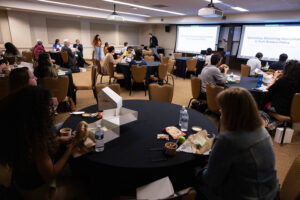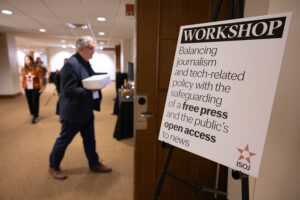April 15, 2024 | Accountability, Blogs, Collaboration, Engagement, ISOJ2024, Trust
ISOJ workshop asks ‘How do we define journalists today?’ amid technological and policy shifts
Lee este artículo en español abajo
View video of this workshop here
Across the world, governments are pursuing public policy to help fund journalism. In the pursuit of effective policy, some states and countries have created definitions of journalism to help determine which individuals and organizations qualify. But in the digital age, creating an adequate definition is easier said than done.
“How is news defined today? How is journalism defined today? And journalists defined today?,” Amy Mitchell asked a room full of media professionals during a workshop at the 25th annual International Symposium on Online Journalism (ISOJ). The workshop was led by Mitchell, the founding executive director at the Center for News, Technology and Innovation (CNTI), an independent non-advocacy research center started in 2023. The center works with journalists, technologists and civil society groups toward the mission of sustaining a healthy news ecosystem.

“To be able to address the opportunities and the challenges of the digital news environment, we all need to work together,” Mitchell said.
During lunch on the second day of the 25th ISOJ, about 25 people joined the workshop titled “Balancing Journalism and Tech Related Policy with the Safeguarding of a Free Press and the Public’s Open Access to News,” for a discussion about how journalists define themselves and the work they do. The workshop also provided a preview of what CNTI will research later this year.
The Center for News, Technology and Innovation is embarking on research to understand not only how journalists define their work, but also how the public defines journalism. Through a series of focus groups and surveys that will be deployed in Australia, Brazil, South Africa and the United States, the center will explore these questions, unraveling how the media sees itself versus how news consumers see the media, and the public policy implications of various definitions.
Senior Research Fellow at CNTI Connie Moon Sehat said the center is “currently seeking collaborations with journalist organizations,” to help develop and deploy the survey. During the workshop, the participants generally agreed that a set of ethical standards sets journalists apart from anyone that shares information with an audience, such as a YouTube host or blogger.
Journalists must have “a commitment to a set of ethics and principles,” including a “sensitivity to conflict of interest,” said Theresa Lalonde, faculty instructor at the British Columbia Institute of Technology and a former reporter and producer for the Canadian Broadcasting Corporation.
Across the world, government bodies including the European Union, Australia, and some states within the U.S. have attempted to define journalism as a matter of public policy. The definitions generally include some kind of ethical standard or mission to support the public interest, but they also can include requirements about the size and revenue stream an organization needs to qualify.
“The reason those definitions are there is to get money,” said Jeff Jarvis, a professor at the Craig Newmark Graduate School of Journalism at the City University of New York. “You have to be an official journalist or journalistic organization” to qualify, Jarvis said, adding that “we need to interrogate that.”

Jarvis appeared on a panel the previous day at ISOJ where he laid out his reasons to oppose the California Journalism Preservation Act, saying that it will mostly benefit large media companies owned by hedge funds while leaving out small, independent publishers and many Black and Latino publications.
The group began a discussion of edge cases where individuals or organizations may be doing journalism without fitting neatly into standard definitions. Mitchell brought up the example of Hugo Travers, who spoke at a panel earlier in the day about how his work in France on the YouTube channel Hugo Décrypte blurred the lines between journalism and digital content creation.
Travers had described his struggles obtaining press passes for his staff of 25 people because the YouTube channel initially did not have a website. Another participant in the workshop described the difficulty that photographers for Wikipedia encountered trying to obtain press credentials to take pictures at major events.
“The lack of definition of journalist in open societies is a feature not a bug,” said Richard Gingras, vice-president of news at Google.
With so much variability in what can be considered journalism and fast-changing technological changes, some participants at the ISOJ workshop were hopeful that the public would also begin changing their perspectives about the media.
“The conversation about our craft has to change in order for people to be able to engage with us more meaningfully,” Lalonde said.
ISOJ is a global online journalism conference organized by the Knight Center for Journalism in the Americas at the University of Texas at Austin. In 2024, it is celebrating 25 years of bringing together journalists, media executives and scholars to discuss the impact of the digital revolution on journalism.
Taller en ISOJ plantea la pregunta: ‘¿Cómo definimos hoy a los periodistas?’, en medio de cambios tecnológicos y políticos
En varias partes del mundo, los gobiernos están aplicando políticas públicas para ayudar a financiar el periodismo. En la búsqueda de una política eficaz, algunos Estados y países han creado definiciones de periodismo para ayudar a determinar qué individuos y organizaciones cumplen los requisitos para recibir financiamiento. Pero en la era digital, crear una definición adecuada es más difícil de lo que se cree.
“¿Cómo se definen hoy las noticias? ¿Cómo se define hoy el periodismo? ¿Y cómo se define hoy a los periodistas?”, preguntó Amy Mitchell a una sala llena de profesionales de los medios de comunicación durante un taller celebrado en el 25 Simposio Internacional de Periodismo Online (ISOJ). El taller fue impartido por Mitchell, directora ejecutiva y fundadora del Center for News, Technology and Innovation (CNTI), un centro de investigación independiente sin ánimo de lucro creado en 2023. El centro trabaja con periodistas, tecnólogos y grupos de la sociedad civil con la misión de mantener un ecosistema de noticias saludable.
“Para poder abordar las oportunidades y los retos del entorno informativo digital, todos tenemos que trabajar juntos”, dijo Mitchell.
Durante el almuerzo del segundo día del 25 ISOJ, unas 25 personas se unieron al taller titulado “Balancing Journalism and Tech Related Policy with the Safeguarding of a Free Press and the Public’s Open Access to News” (Equilibrio entre periodismo y políticas relacionadas con tecnología con la salvaguarda de una prensa libre y el acceso abierto del público a las noticias), para debatir sobre cómo se definen a sí mismos los periodistas y el trabajo que realizan. El taller también ofreció un avance de lo que el CNTI investigará más adelante este año.
La organización se embarcará en una investigación para comprender no sólo cómo definen su trabajo los periodistas, sino también cómo lo define el público. A través de una serie de grupos de discusión y encuestas que se llevarán a cabo en Australia, Brasil, Sudáfrica y Estados Unidos, el centro explorará estas cuestiones, desentrañando cómo los medios de comunicación se ven a sí mismos frente a cómo los consumidores de noticias ven a los medios, y las implicaciones de política pública de las diversas definiciones.
Connie Moon Sehat, investigadora senior del CNTI, explicó que el centro “está buscando actualmente colaboraciones con organizaciones de periodistas” para ayudar a desarrollar y desplegar la encuesta. Durante el taller, los participantes coincidieron en general en que un conjunto de normas éticas diferencia a los periodistas de cualquier persona que comparta información con un público, como un presentador de YouTube o un bloguero.
Los periodistas deben estar “comprometidos con una serie de principios éticos”, incluida la “sensibilidad ante los conflictos de intereses”, dijo Theresa Lalonde, profesora del British Columbia Institute of Technology y antigua reportera y productora de la Canadian Broadcasting Corporation.
En todo el mundo, organismos gubernamentales como la Unión Europea, Australia y algunos estados de Estados Unidos han intentado definir el periodismo como una cuestión de política pública. Las definiciones suelen incluir algún tipo de norma ética o misión de apoyo al interés público, pero también pueden incluir requisitos sobre el tamaño y el flujo de ingresos que necesita una organización para calificar.
“La razón por la que esas definiciones están ahí para conseguir dinero”, dijo Jeff Jarvis, profesor de la Craig Newmark Graduate School of Journalism de la City University de Nueva York. “Tienes que ser un periodista oficial o una organización periodística para calificar. […] Tenemos que examinar eso”.
El día anterior, Jarvis participó en un opanel en ISOJ en el que expuso sus razones para oponerse a la Ley de Preservación del Periodismo de California, afirmando que esta beneficiará sobre todo a las grandes empresas de medios de comunicación propiedad de fondos especulativos y dejará fuera a los pequeños editores independientes y a muchas publicaciones negras y latinas.
El grupo debatió sobre los casos extremos en los que individuos u organizaciones pueden estar haciendo periodismo sin encajar claramente en las definiciones estándar. Mitchell mencionó el ejemplo de Hugo Travers, quien habló en un panel previo sobre cómo su trabajo en Francia en el canal de YouTube HugoDécrypte difuminaba las fronteras entre el periodismo y la creación de contenidos digitales.
Travers describió sus dificultades para obtener pases de prensa para su plantilla de 25 personas porque el canal de YouTube no tenía inicialmente una página web. Otro participante en el taller describió las dificultades que tuvieron los fotógrafos de Wikipedia para obtener credenciales de prensa para tomar fotografías en grandes eventos.
“La falta de una definición de periodista en las sociedades abiertas es una característica, no un defecto”, dijo Richard Gingras, Vicepresidente de Noticias de Google.
Con tanta variabilidad en lo que puede considerarse periodismo y los rápidos cambios tecnológicos, algunos participantes en el taller de ISOJ confiaron en que el público también comenzará a cambiar sus perspectivas sobre los medios de comunicación.
“La conversación sobre nuestro oficio tiene que cambiar para que la gente pueda relacionarse con nosotros de forma más significativa”, dijo Lalonde.
ISOJ es una conferencia mundial de periodismo en línea organizada por el Centro Knight para el Periodismo en las Américas de la Universidad de Texas en Austin. En 2024, celebra 25 años de reunir a periodistas, ejecutivos de medios de comunicación y académicos para debatir el impacto de la revolución digital en el periodismo.

